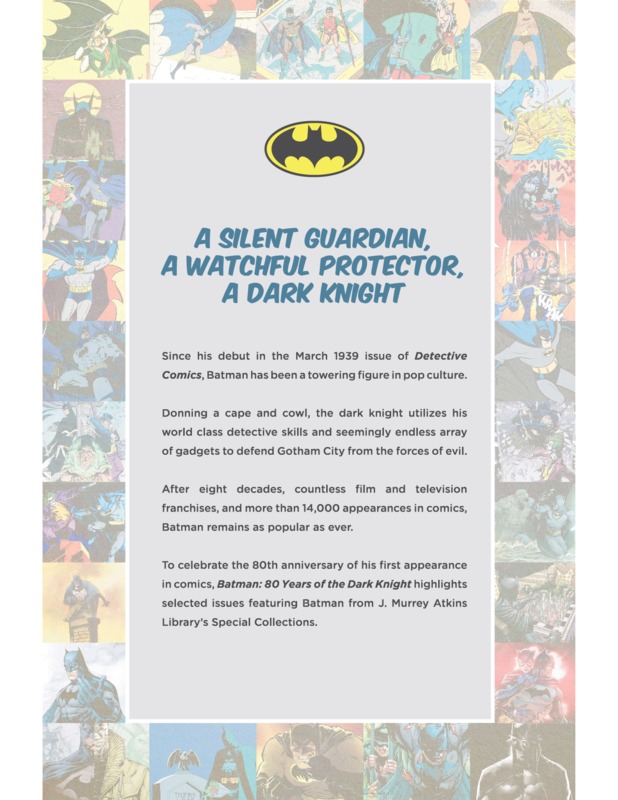80th Anniversary of Batman
The 80th Anniversary of Batman
Since his debut in the March 1939 issue of Detective Comics, Batman has been a towering figure in pop culture. Donning a cape and cowl, the dark knight utilizes his world class detective skills and seemingly endless array of gadgets to defend Gotham City from the forces of evil.
After eight decades, countless film and television franchises, and more than 14,000 appearances in comics, Batman remains as popular as ever. To celebrate the 80th anniversary of his first appearance in comics, Batman: 80 Years of the Dark Knight highlights selected issues featuring Batman from J. Murrey Atkins Library’s Special Collections.
The graphic novels included in the exhibit are listed below:
- Batman #185
- Batman #186
- Batman #189
- Batman #190
- Batman #199
- Batman #200
- Batman #202
- The Brave and the Bold #78
- Detective Comics #359
- Detective Comics #365
- Detective Comics #367
- Detective Comics #373
- Detective Comics #377
- Justice League of America #59
- Justice League of America #61
- Justice League of America #62
Exhibit curated by Marc Bess, First Year & Online Learning Librarian, and Randi Beem, Instruction Librarian/Archivist
Background Information
Origins
Created by Bill Finger and Bob Kane, Batman was part of the first wave of comic book superheroes that captured the public’s attention.
Following the debut of Superman in 1938, the demand for superheroes in comics was at a fever pitch. This era of comics would become known as the Golden Age (1938 - 1956).
While considerably grimmer in tone than Superman, Batman proved to be an instant success with readers of all ages. Less than a year after his first appearance, Batman was not only appearing in the pages of the anthology Detective Comics, but in his own ongoing series.
The concept of a shared universe was quickly developed during the early years of superhero comics. This allowed Batman to team up with popular characters from other DC Comics series such as Superman to battle a common foe.
The DC Comics roster of the 1940s would soon include other iconic characters such as Wonder Woman, The Flash, and Green Lantern.
As the United States entered World War II, sales figures for superhero comics skyrocketed. Comic books provided a cheap
source of entertainment for both soldiers fighting overseas and children stateside.
Though it looked like America’s obsession with superheroes would never wane, changes in society would challenge their relevance as the war came to a close.
The Silver Age
Following the end of World War II, sales of superhero comics plummeted. This can be attributed to a variety of factors, including the growing relevance of television as a form of entertainment and a moral panic that arose over purported connections between comics and juvenile delinquency.
Though Batman has been continuously published since his debut, less popular characters such as The Flash and Green Lantern ceased appearing in comics. For several years, it appeared as if superhero comics were just another fad.
This changed in 1956. The Flash’s reappearance in the anthology series Showcase sparked a new wave of interest in superheroes that reasserted their dominance of comic books and expanded to new forms of media. This event was the start of the Silver Age of comics (1956 - early 1970s).
The Silver Age saw Batman reach almost unrivaled levels of popularity, from appearing in multiple ongoing comic book series to starring in his own primetime TV show. The comics in this exhibit are all examples of Batman’s Silver Age appearances.
Far from the grim and gritty storylines that would define the character in the 1980s and 1990s, Batman comics of the 1960s
displayed a fun tone that made the character appealing to a wide range of audiences.
The comics in this exhibit are part of the Charles K. Johnston comic book collection. This collection was donated to Special Collections by Charles K. Johnston in 1969.
Books from the Stacks
The following books were included in the exhibit to complement the scholarly research of graphic novels and the Batman series in particular.
Baetens, Jan. The Graphic Novel . Louvain, Belgium: Leuven University Press, 2001.
Batgirl : a Celebration of 50 Years. Burbank, CA: DC Comics, 2017.
Gravett, Paul. Graphic Novels : Everything You Need to Know . New York: Collins Design, 2005.
McCloud, Scott. Reinventing Comics. New York, N.Y: HarperCollins, 2000.
McLaughlin, Jeff. Comics as Philosophy. Jackson: University Press of Mississippi, 2005.
Miller, Frank et al. Batman : the Dark Knight Returns. New York, New York: DC Comics, 2002.








